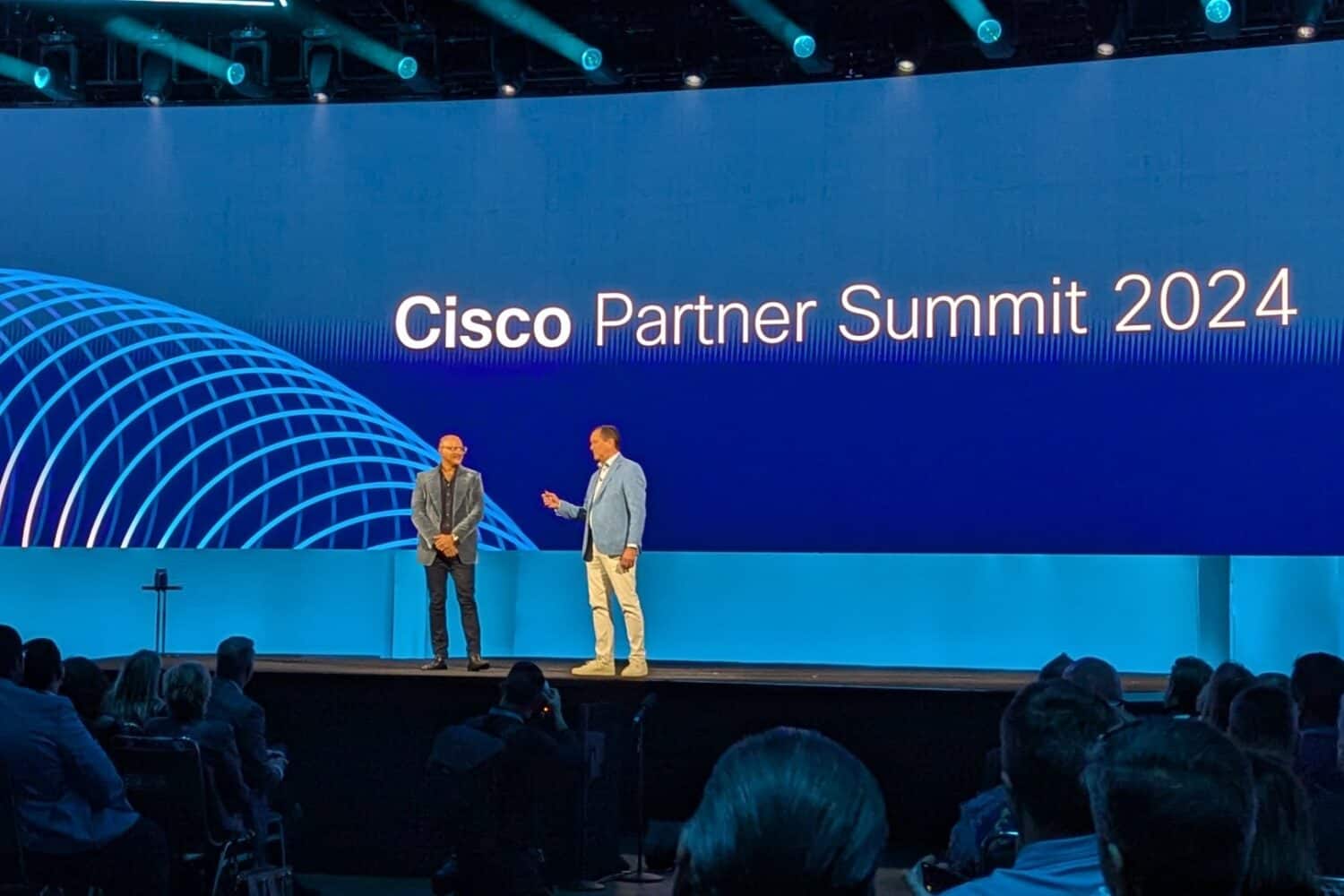Cisco is in the midst of a fundamental restructuring. It has been underway for several years, but got a face earlier this year with the appointment of Jeetu Patel as Chief Product Officer. He is responsible for laying down an integrated product portfolio across the entire breadth of Cisco’s offerings. We spoke with him about this huge job, which is certainly not finished but is taking shape.
About five years ago, Cisco seemed to have slowed down a bit in terms of innovation. The company was certainly not at the forefront of innovation in quite a few areas and seemed to be mostly maintaining the status quo. In itself, this is not surprising for a company the size of Cisco. There was still innovation in the various parts of the company. As an innovation platform, however, it did not make that much progress. In order to keep up and do better than the rest of the market, that had to change.
You could see the hiring of Patel in 2020 (who came from the relatively small Box, where he was Chief Product Officer) as an important step toward modernizing Cisco. After all, in doing so, the company brought in the mindset of a smaller company. A company where they were very much aware that things like openness and integrations are crucial to success in the modern IT landscape.
The challenge for Cisco
Meanwhile at Cisco, Patel has also made it to Chief Product Officer (until recently he was responsible for the company’s security and collaboration business) and can really work with his teams to rebuild the portfolio.
Reshaping the portfolio was and is really necessary, Patel points out: “Cisco has grown over the years. What happens then is that within the organization someone is responsible for the networking component, someone for compute, someone for security, someone for observability and so on.” The problem, however, was that they could not maximize the capabilities of all those components. Cisco could not get a “structural advantage” from the combination of the parts, in Patel’s words.
So the task for Patel and effectively everyone at Cisco was clear: The company had to fundamentally change in order to do grab that advantage. That meant quite a lot for a company that in 30 years or so had grown into one of the giants of the IT industry. Quite apart from the changes that were and are necessary in terms of technology and innovation, a lot had to change in terms of corporate culture as well. That is something for which Patel puts a feather in Chuck Robbins’ cap. The CEO of Cisco, he says, is doing that very well. This mainly involves much more focus on the customer than was previously the case. For example, Cisco has had a CX (Customer Experience) business unit for some time now.
How does Cisco get a structural advantage?
However, wanting to gain a structural advantage by looking at one’s own organization differently is only the first step. It must then actually be realized. That is not always easy, especially with a company the size of Cisco. In addition, Cisco is also dealing with customers who are often part of critical infrastructure. In other words, it all has to be done in a thoughtful and responsible way.
To accomplish this, Patel has three core principles. The first is that a company must build products that people love. “People should talk about it to friends and family,” Patel adds some more color to this sentiment. This may sound a bit excessive within the world in which a company like Cisco operates, but it is of great importance according to him. That’s the only way to get a high adoption rate and therefore commercial success.
The second principle is that Cisco’s products must be able to function in an open ecosystem. This is crucial, according to Patel. “If a customer has already invested in competing technology, we have to support that,” he indicates.
Finally, Patel mentions as a third principle that products must be significantly better than those of the competition. “No one has ever beaten the competition by being 10 percent better, we have to be 10 times better,” according to him. We are used to statements like this from Patel, for whom hyperbole is a beloved figure of speech. When introducing the completely revamped Webex platform a few years ago, he said that virtual meetings would be 10 times better than physical meetings. In any case, it leaves little misunderstanding of Cisco’s intention, even if the “10 times” may be metaphor rather than something actually measurable or going to happen.
How do Cisco’s customers benefit?
By following the above three principles, Patel says Cisco can offer customers benefits that other companies cannot. This is possible by seeing everything as part of a larger platform and developing accordingly. This helps customers, because they often say they have too much software. So they benefit from an integrated platform, is the idea.
To clarify what he means by an integrated platform, Patel cites an example from the consumer market. When switching to a new phone, he does not compare an iPhone’s camera to that of a Google Pixel. This is because he takes an iPhone anyway. Cisco wants to achieve the same with customers. That way, it can also greatly increase the value of the platform. “The cost of adding new technologies to the platform goes down precipitously with this,” he indicates. This is ultimately in the customer’s interest as well.
It is not just about integrating hardware with the software that runs on top of it for Cisco. We should not forget that Cisco also has a chip design division. Hyperscalers use SiliconOne chips for use in their data centers, for example. In addition, it is also a key component is HyperFabric, which it announced earlier this year. This allows Cisco to offer a full-stack platform that focuses both on the customer but also on an open ecosystem. Patel calls Cisco “platform-obsessed” at this point of our conversation.
Are there limits to an open platform?
The above account by Patel certainly sounds good. Moreover, based on what we hear from the market and what is needed, it is certainly a good strategy. Still, it does contain some parts that raise some questions for us. Will Cisco also walk the walk after it talks the talk? And how will Cisco achieve and keep the right balance between openness and thus integration with other products (sometimes of direct competitors) and its own products/platform?
Patel immediately agrees that Cisco needs to strike the right balance. From that perspective, the Apple example he gives above does not quite hold up to scrutiny. After all, Apple is not open at all and supports virtually nothing but Apple products. That is, of course, their right and, given their business results, only logical. However, it is not what Cisco is aiming for with its integrated platform. That should also support technology, products and services from other companies.
Examples of that openness are apparent in Cisco’s portfolio. For example, Cisco has made Webex devices suitable for Microsoft Teams. In addition, the Cisco Security Cloud (and the XDR offering underneath it) can handle data and telemetry from other platforms. Within the networking part, we don’t really see such openness happening yet, by the way. Cisco is so dominant in that market that it is not really necessary (yet). In collaboration and security, it is a lot less dominant. There it is also just a necessity for the company.
Cisco does not take the easiest route
To completely shake up an organization the size of Cisco is a very fundamental change. But it was really necessary. Cisco was simply missing out on too much, according to Patel. Consider the compute division, which we heard quite a lot about this year for the first time in years. Or the security division, which also didn’t have a huge amount of focus until a few years ago.
“Five years ago we had too little focus on that,” Patel also readily admits, talking specifically about the security offering. So in recent years, Cisco has invested a lot in this division. We’ve written about that several times. Think of things like Security Cloud and Hypershield. Cisco is still not at the growth rates of 30 percent or more that other security players are notching up. It’s sitting around 15 percent. It is still a fairly delicate growth rate, as last quarter it was suddenly only seven percent due to the temporary loss of a large government customer. However, Patel otherwise sees consistent growth, which he believes is continuing.
Cisco could have chosen a simpler route in the area of security. They could have simply built on an existing product and achieved quite a bit of growth with it very quickly. “We could have chosen not to build and launch the Security Cloud and grown a point solution very quickly,” Patel points out. But, “doing something right simply takes longer,” he believes. “This may mean that sometimes we are a few months later with new products, but we want to get it right,” he continues.
At the end of the day, Cisco has rigged up a substantial longer-term vision. That may mean that it will take several years of investment before the effects are evident. Not only in the products, but also in Cisco’s organization itself. “The organization now demands integration,” according to Patel, something that was not the case before. That, coupled with the “ten-year horizon” that Cisco is working toward with an open platform should start to make a big difference for Cisco in the marketplace.

